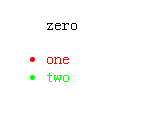深入理解css3中 nth-child 和 nth-of-type 的区别
在css3中有两个新的选择器可以选择父元素下对应的子元素,一个是:nth-child 另一个是:nth-of-type。 但是它们到底有什么区别呢?
其实区别很简单::nth-of-type为什么要叫:nth-of-type?因为它是以"type"来区分的。也就是说:ele:nth-of-type(n)是指父元素下第n个ele元素,
而ele:nth-child(n)是指父元素下第n个元素且这个元素为ele,若不是,则选择失败。
而ele:nth-child(n)是指父元素下第n个元素且这个元素为ele,若不是,则选择失败。
文字未免听起来比较晦涩,便于理解,这里附上一个小例子:
<!DOCTYPE html> <html lang="en"> <head> <meta charset="UTF-8"> <title>demo</title> </head> <style> .demo li:nth-child(2) { color: #ff0000; } .demo li:nth-of-type(2) { color: #00ff00; } </style> <body> <div> <ul class="demo"> <p>zero</p> <li>one</li> <li>two</li> </ul> </div> </body> </html>
结果如下:

上面这个例子,.demo li:nth-child(2)选择的是<li>one</li>节点,而.demo li:nth-of-type(2)则选择的是<li>two</li>节点。
但是如果在nth-child和 nth-of-type前不指定标签呢?
<style> .demo :nth-child(2) { color: #ff0000; } .demo :nth-of-type(2) { color: #00ff00; } </style>
这样又会是什么结果呢,看下html结构:
<ul class="demo"> <p>first p</p> <li>first li</li> <li>second li</li> <p>second p</p> </ul>

如上可见,在他们之前不指定标签类型,:nth-child(2) 选中依旧是第二个元素,无论它是什么标签。而 :nth-type-of(2) 选中了两个元素,分别是父级.demo中的第二个p标签和第二个li标签,由此可见,不指定标签类型时,:nth-type-of(2)会选中所有类型标签的第二个。
我们已经了解了nth-child和 nth-of-type的基本使用与区别,那么更进一步nth-of-type(n)与nth-child(n)中的n是什么呢?数字:也就是上面例子的使用,就不做赘述。
关键词:Odd 、even
Odd 和 even 是可用于匹配下标是奇数或偶数的子元素的关键词
注意:第一个子元素的下标是 1
在这里,我们为奇数和偶数 p 元素指定两种不同的背景色:
<style> p:nth-of-type(odd) { background: #ff0000; } p:nth-of-type(even) { background: #0000ff; } </style>
公式:或者说是算术表达式
使用公式 (an + b)。描述:表示周期的长度,n 是计数器(从 0 开始),b 是偏移值。在这里,我们指定了下标是 3 的倍数的所有 p 元素的背景色:
<style> p:nth-of-type(3n+0) { background: #ff0000; } </style>
若是 :nth-of-type(4n+2) 就是选择下标是4的倍数加上2的所有元素


 浙公网安备 33010602011771号
浙公网安备 33010602011771号